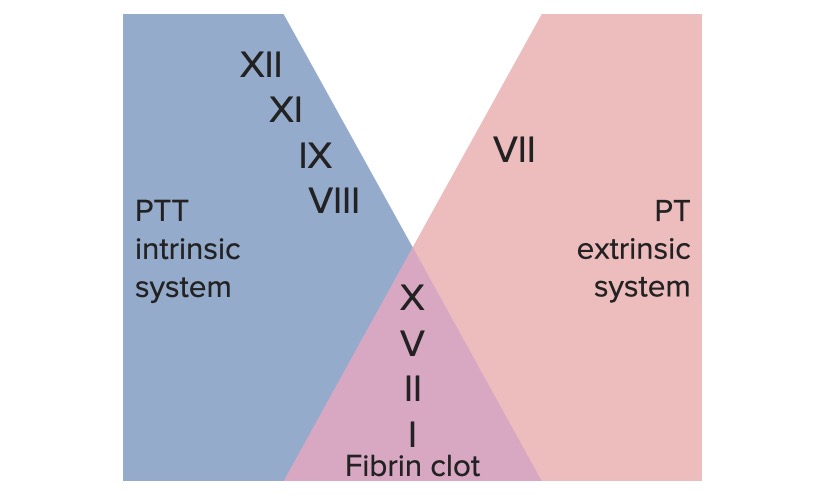Playlist
Show Playlist
Hide Playlist
Thrombolysis
-
Slides Thromboregulation Thrombolysis Normal Hemostasis.pdf
-
Reference List Pathology.pdf
-
Download Lecture Overview
00:00 So here we are in our bloodstream with our definitive hemostatic plug and we have platelets that have also been cemented together by polymerized fibrin. Even as that is being made as we've talked about, thrombin also in that plug is acting on adjacent endothelial cells to drive a number of processes. One of which is the production of tissue plasminogen activator or tPA. It also produces urokinase, but for all intensive purposes we're going to focus on tissue plasminogen activator. Those endothelial cells make this molecule which will associate with the growing platelet fibrin thrombus. It's going to be important kind of regulatory molecule because it's going to act on a circulating molecule called plasminogen and plasminogen are those blue bars that you see that are also sticking into the platelet fibrin plug. That plasminogen will be cleaved by tissue plasminogen activator, just like the name says, and will convert it into a form that will give it proteolytic activity to cleave the fibrin to release fibrin degradation products. So we will start removing the cement from that platelet fibrin plug as a result of the activity of plasmin derived from the cleavage of plasminogen driven by the activity of tissue plasminogen activator. Now those fibrin degradation products that you see on the right hand side, those actually can be used to measure the fact whether or not we have in the body an ongoing thrombosis and antithrombosis process and it can be a very important biomarker for people who might be developing deep venous thrombosis or pulmonary embolization. So keep that in mind too that has important prognostic and diagnostic significance. Okay, so that's what is going on with tissue plasminogen activator acting on plasminogen to make plasmin to break down the fibrin crosslinks. However, there are various ways that we regulate that so the regulators are being regulated and endothelial cells, depending on their state of activation, make plasminogen activator inhibitor. So it's kind of a double negative. It's an activator inhibitor. 02:30 Sorry, I didn't name it. But that's going to act on tPA and turn it off. So, endothelial cells can give it and they can take it away in terms of the activity acting on plasminogen to make plasmin. One final point, say that plasmin that's been activated, it's kind of chewed up, it's a little bit semi-circular, and it's able to chew on fibrin. We don't want that working some place else in the body. We may want it in the clotting here, but we may have clots some place else we don't want to tear down. So how do we keep that plasmin that's been activated from doing its job in the wrong location. Well in fact, what we have now circulating to, again synthesized by the liver, is alpha2-antiplasmin. So it's a small molecule that will bind to any free plasmin that happens to get into the circulation and it will inactivate it. 03:28 So we can keep any free plasmin that goes rouge and keep it from chewing on a clot some place else where we don't want it to act. So, you can see that again there are some very important regulatory and counterregulatory pathways that modulate, that control thrombolysis. Okay, once we formed a thrombus, we can't just leave it there. Clearly, that vessel is perfusing some tissue and eventually, gee, we might like to restore blood flow into that tissue. How do we do that? So this is truly organization of an exudate. A blood clot, a thrombus is an exudate, it is an accumulation of plasma proteins that have aggregated. 04:16 We need to clean that up. We can't just leave it lying around, 1 because it could get potentially infected but 2, it's blocking blood flow through this vessel. So that's what we're looking now on the right is a thrombus that is undergoing organization. So what happens to organize the thrombus? We have to, from the vessel wall, bring in macrophages and they will be involved in the definitive catabolism of the thrombus. So they will munch on all those platelets. They will munch on all of the protein that's aggregated and they will break it down into a form that can be washed away. The secondary wave is that we will have a migration proliferation of endothelium. So we will bring in blood vessels that will organize this thrombus. 05:00 This is just wound healing, this is an exudate organization. Followed on that wave of new ingrowth of endothelium will be fibroblast and those fibroblasts will synthesize matrix and hopefully we will get some remodelling and eventually the goal is to restore this lumen to as much of its normal patency as it originally had.
About the Lecture
The lecture Thrombolysis by Richard Mitchell, MD, PhD is from the course Hemostasis.
Included Quiz Questions
Thrombolysis results in the formation of...
- ...fibrin degradation products.
- ...plasmin.
- ...plasminogen.
- ...tissue plasminogen activator.
- ...a2-antiplasmin.
Fibrin degradation products are important prognostic indicators of what condition?
- Pulmonary embolism
- Tuberculosis
- Emphysema
- Asthma
- Bronchitis
What is an important step during thrombus organization?
- Angiogenesis
- Platelet adhesion
- Platelet aggregation
- Fibrinolysis
- Plasminogen activation
Customer reviews
5,0 of 5 stars
| 5 Stars |
|
1 |
| 4 Stars |
|
0 |
| 3 Stars |
|
0 |
| 2 Stars |
|
0 |
| 1 Star |
|
0 |
loved the lecture. extremely easy to understand . Simplified , illustrated and comprehensive




